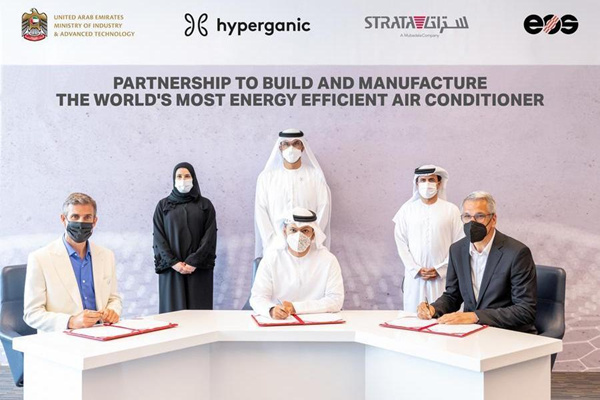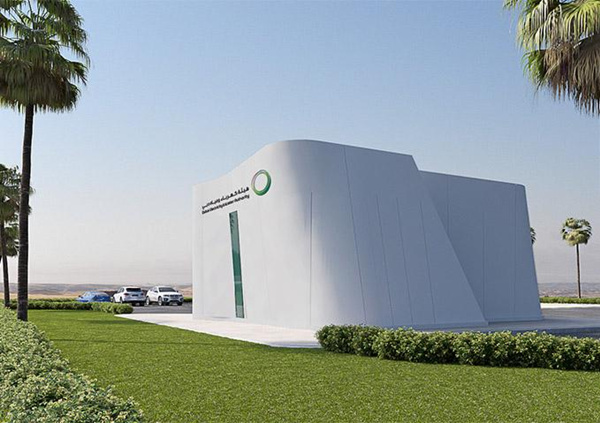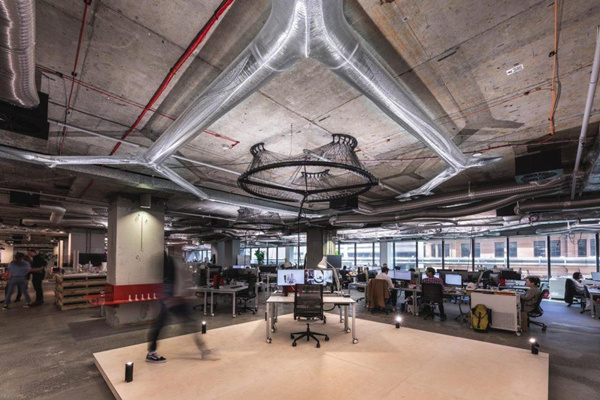Leading 3D printermanufacturer EOS has agreed to help develop residential air conditioning (AC) systems that are up to ten times more efficient than the norm. EOS is said to have partnered with UAE-based aerospace company Strata Manufacturing and AI engineering platform developer Hyperganic to create a system that is "highly sought after in the global marketplace". As such, Dr Sultan Ahmed Al Jaber, UAE Minister of Industry and Advanced Technology, claims that the resulting unit will showcase how his country can meet domestic and international demand.
"The partnership between Hyperganic, EOS and Strata demonstrates how the UAE manufacturing industry can develop and launch globally competitive, home-grown products," Al Jaber asserts. "Developing competitive, marketable products will boost the UAE's industrial sector and have a positive impact on the national economy."

Participants in the project sign their partnership agreement. Image via Zawya.
UAE makes big push for 3D printing
EOS' air conditioning programme is just the latest in a series of 3D printing projects taking place in the UAE, which has become a regional hub for the technology in recent years. This is particularly true of the country's construction industry, with Prime Minister Mohammed bin Rashid Al Maktoum even issuing a 3D printing decree to regulate how it is used locally. Over the past five years, the UAE has become home to an ambitious portfolio of additive manufacturing infrastructure. Since Immensa Labs set up the UAE's first 3D printing facility in 2017, WASP has used the technology to 3D print at the country's beachfront Dior shop, and CyBe has contracted to 3D print houses there. At state level, the Dubai Electricity and Water Authority (DEWA) has also launched the world's first 3D printing research lab at the emirate's 77 square kilometre solar park. As a base for rover and drone development and 3D printing of spare parts, the facility could be a potential driver of cost and delivery time savings in DEWA's operations. "In line with our leadership's directive to support and develop the national industrial sector, the Department of Industry and Advanced Technology aims to develop the national industrial ecosystem," added Al Jaber. "This exciting new technology is an ideal example of how innovation can drive sustainable development and have a positive economic impact."

Concept view of the DEWA 3D Printing R&D Centre. Photo from DEWA.
Developing more sustainable air conditioning
Citing data from the International Energy Agency, Hyperganic, EOS and Strata say that the energy demand for air conditioning is expected to triple by 2050. With this development, which equates to 10 new units being turned on every second for 28 years, and air conditioning units already accounting for 10% of global energy use, the project team is pressing for changes to avoid environmental impacts.
To bring about the necessary changes, the three companies have now signed a partnership agreement at an official ceremony through which they have committed to developing their own new, greener air conditioning units. In practice, the project will see Hyperganic's algorithmic engineering approach combined with EOS's metal 3D printing technology to develop a novel, energy-efficient alternative to air cooling.
Hyperganic has also announced plans to open a new UAE engineering office in early July 2022, with a team of engineers set to reach 20 by the end of next year, who will work with teams from Strata and EOS to help introduce the system to bear fruit. While the companies did not outline how their air conditioning division will achieve the proposed efficiency gains, or what role 3D printing will play in making this happen, they plan to provide an update at COP28 in Dubai in 2023. According to EOS founder Dr . Hans Langer, the project will require "a deep integration of engineering and manufacturing", but it could "significantly advance state-of-the-art technology".

The 3D printed 'SR2' air filtration system installed at BVN Architecture's Sydney studio. Image from the School of Architecture, University of Technology Sydney.
Self-regulating for heat
Over the last year, 3D printing has been used to develop a range of methods to transform building construction processes that address the challenges of heat regulation. Researchers at the UTS School of Architecture in Australia worked with a team from BVN Architecture to automatically 3D print air conditioning units from recycled plastic, thereby reducing their carbon content by 90%. Meanwhile, at Texas A&M University, engineers have taken a different approach to the problem, developing a new type of phase change 3D printing material. The resin can be DIW 3D printed into structures that can change shape to absorb heat, which could make them ideal for building insulating infrastructure.
Elsewhere, researchers at the Egyptian-based British University and Cosign Group have also come up with a new material, albeit one that contains biomass and plastic. It is thought that the algae-laden 3D-printed filament could soon be used to create a circular alternative to traditional glass surfaces, which its creators have dubbed 'living architecture'.





